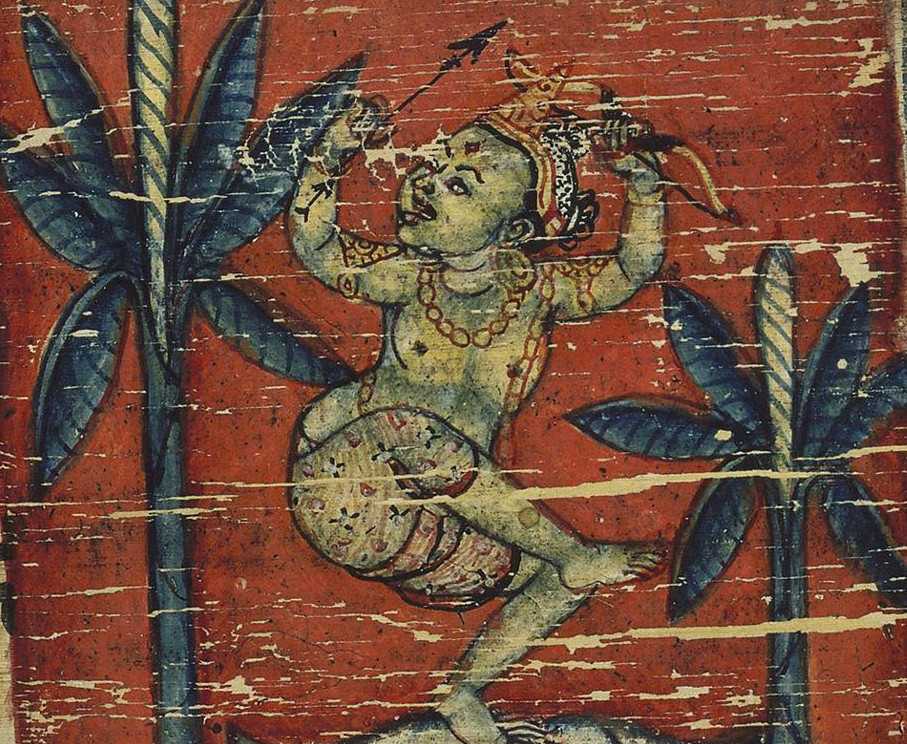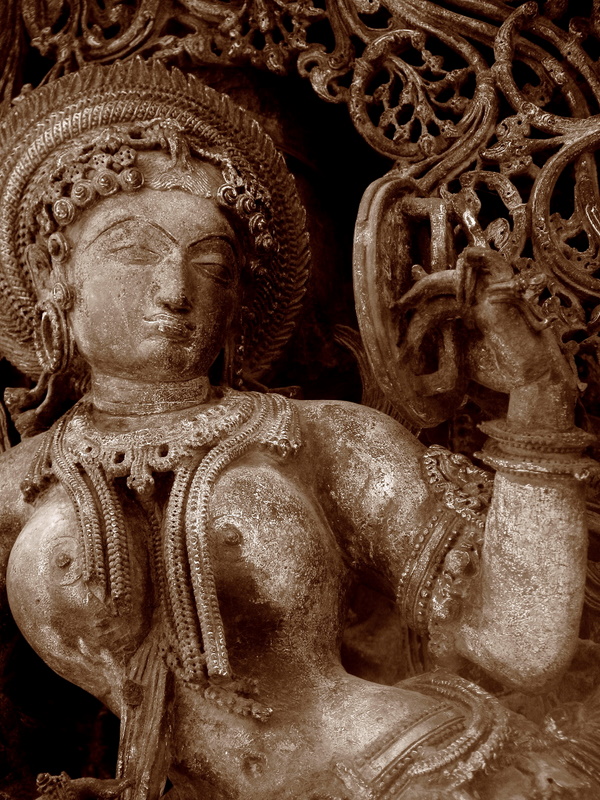The Way of the Poet-King
Poetics at the Court of Amōghavarṣa
Andrew Ollett g July 4, 2017
licensed under CC BY-SA 4.0
Table of Contents
- The Daṇḍin Model of Poetics
- The Amōghavarṣa Model of Poetics
- Revising Dismissal (ākṣēpa-)
Acknowledgements

Yigal Bronner

Sarah Pierce Taylor
The Daṇḍin Model of Poetics
Kāñcīpuram, around 700 CE
Place: Kāñcīpuram, city of the Pallavas
Time: around 700 CE
Daṇḍin composes his Mirror of Literature (Kāvyādarśaḥ).
Daṇḍin’s Mirror of Literature
written in Sanskrit ślokas in three chapters:
- The Ways of Literature (mārgavibhāgaḥ)
- Ornaments of Meaning (arthālaṁkāraḥ)
- Difficult Techniques (duṣkaraḥ)
The Amōghavarṣa Model of Poetics
Maḷkhēḍ, around 870 CE
Place: Mānyakhēṭa, city of the Rāṣṭrakūṭas
Time: around 870 CE
Śrīvijaya composes his Way of the Poet-King (Kavirājamārgaṁ) at the court of the Rāṣṭrakūṭa King Amōghavarṣa.
Śrīvijaya’s Way of the Poet-King
written in Kannada kandas in three chapters:
- Introduction
- Ornaments of Sound
- Ornaments of Meaning
An image of a manuscript
Questions for this talk
- How can we see the Way of the Poet-King as a reading of, or even a commentary on, Daṇḍin’s Mirror of Literature?
- What kinds of interventions does the Way make into the treatment of individual ornaments? (≈ how does the vernacular “write back”?)
- How does the Way reimagine the system of literary knowledge that Daṇḍin had provided in the Mirror of Literature?
Ākṣēpaḥ or Dismissal
A
Ākṣēpaḥ
orDismissal
A
Ākṣēpaḥ or Dismissal
“The word ākṣepa is post-epic. Whether its earliest meaning was ‘hint’ or ‘denial’ or ‘censure’ I cannot say, for it bears all these senses in the later literature. As a technical name of a figure of speech it is defined by all the Ālaṅkārikas starting from Bhāmaha and Daṇḍin. Usually it is defined as a denial (pratiṣedha, niṣedha) which hints at something unexpressed.”
(Ingalls’ note on Dhvanyālokalōcana 1.13e.)
The two discussions at a glance
Daṇḍin (2.120–166)
DefinitionExamples and discussion according to time:
- past, present, future
Examples and discussion
according to what is dismissed:
- property, property-possessor, cause, effect, assent, denial, disrepsect, blessing, harshness, accompaniment, effort, helplessness, remedy, anger, compassion, regret, embrace, doubt, case in point, reason
Śrīvijaya (3.99–107)
Definition and example
Examples and discussion:
embrace, comparison, doubt, reason
Conclusion
The two discussions at a glance
We can already see that Śrīvijaya’s discussion is drawn from the very beginning and end of Daṇḍin’s discussion.
- He bypasses a whole series of examples inspired by Prakrit poetry, where a woman attempts to stop her husband from leaving on a trip (ākṣēpaḥ = ‘chastisement’)
- He focuses, instead, on a selection of subvarieties where logical structures are important, like doubt and reason (ākṣēpaḥ = ‘negation’).
What does Śrīvijaya skip?
Here is an example of Daṇḍin’s harsh dismissal (2.143)
yadi satyaiva tē yātrā
kāpy anyā mr̥gyatāṁ tvayā
aham adyaiva ruddhāsmi
randhrāpēkṣēṇa mr̥tyunā
What does Śrīvijaya skip?
Here is an example of Daṇḍin’s harsh dismissal (2.143)
If you’re really going,
go hunt after some other girl.
From now on I’m spoken for—
by death, who’s waiting in the wings.
Introducing ‘Dismissal’
in Mirror 2.120–122

Daṇḍin’s introduction
Mirror 2.120:
pratiṣēdhōktir ākṣēpas
traikālyāpēkṣayā tridhā
athāsya punar ākṣēpya-
bhēdānantyād anantatā
Daṇḍin’s introduction
Mirror 2.120:
Dismissal is the statement of a denial.
It is threefold, in view of the three times.
Or rather, it is infinite, on account of the
infinite variety of things that can be dismissed.
Daṇḍin’s first example
Mirror 2.121:
anaṅgaḥ pañcabhiḥ pauṣpair
viśvaṁ vyajayatēṣubhiḥ
ity asaṁbhāvyam athavā
vicitrā vastuśaktayaḥ
Daṇḍin’s first example
Mirror 2.121:
It’s unbelievable that the Bodiless God
conquered the world with five arrows
made of flowers. Or maybe not:
the powers of things might surprise you.
Daṇḍin’s discussion of his first example
Mirror 2.122:
ity anaṅgajayāyōga-
buddhir hētubalād iha
pravr̥ttaiva yad ākṣiptā
vr̥ttākṣēpas tad īdr̥śaḥ
Daṇḍin’s discussion of his first example
Mirror 2.122:
This kind is past dismissal, since the notion
that the Bodiless God’s victory doesn’t
make sense, which has already come about
on the strength of those reasons, is dismissed.
Introducing ‘Dismissal’
in Way 3.99–100

Śrīvijaya’s introduction
Way 3.99:
viditārthaviparyāsā-
spadame dal ākṣēpam emb’ aḷaṁkāraṁ ma-
tt’ adaṟa viśēṣavibhāgama-
n udāharaṇamārgadiṁ prayōgisi tōrpeṁ
Śrīvijaya’s introduction
Way 3.99:
Dismissal is an ornament based on
controverting a meaning already known.
I will now illustrate particular varieties
of it in practice, by way of example.
Śrīvijaya’s first example
Way 3.100:
mr̥dutaramārgade kennaṁ
madana-śarānīkam oykan olavaṁ paḍeguṁ
hr̥dayaman adavaḻalind’ uṟe
vidārisuvud’ intu kusumamayam alt’ adaṟiṁ
Śrīvijaya’s first example
Way 3.100:
To be sure, the arrowhead of the God of Love
gains its entrance by the most tender of paths.
But then it completely tears the heart apart
with grief. That’s why it can’t be made of flowers.
Setting the tone
- Śrīvijaya presupposes Daṇḍin’s interventions…
- specifically, the ‘dismissal’ of a temporal classification (traikālya-)
- … and responds to Daṇḍin’s examples
- by ‘dismissing’ the reason (pauṣpatā) given in Daṇḍin’s verse
Breaking the Mirror

Daṇḍin’s ‘Doubt Dismissal’ (Example)
Mirror 2.161:
kim ayaṁ śaradambhōdaḥ
kiṁ vā haṁsakadambakam
rutaṁ nūpurusaṁvādi
śrūyatē tan na tōyadaḥ
Daṇḍin’s ‘Doubt Dismissal’ (Example)
Mirror 2.161:
It this an autumn cloud?
Or a flock of geese?
You can hear something like anklets.
So it’s not a cloud.
Daṇḍin’s ‘Doubt Dismissal’ (Explanation)
Mirror 2.162:
ity ayaṁ saṁśayākṣēpaḥ
saṁśayō yan nirvartyatē
dharmēṇa haṁsasulabhē-
nāspr̥ṣṭaghanajātinā
Daṇḍin’s ‘Doubt Dismissal’ (Explanation)
Mirror 2.162:
This is a doubt dismissal,
where the doubt is removed through a property
that is commonly found in geese
but doesn’t pertain to clouds as a class.
Śrīvijaya’s ‘Comparison Dismissal’
Way 3.103:
varahaṁsakadambakam adu
śaradambudam altu mukharanūpurasaṁvā-
diravaṁ negaḻd’ appudu ban-
dhuram adaṟind’ idaṟoḷ embud’ upamākṣēpaṁ
Śrīvijaya’s ‘Comparison Dismissal’
Way 3.103:
“That’s a flock of beautiful geese, not
an autumn cloud, since the lovely sound
of tinkling anklets is arising from it.”—
this is what is called a comparison dismissal.
Śrīvijaya’s ‘Doubt Dismissal’
Way 3.104:
madakariyō ghanasamayām-
budamō ghanam altu negaḻvud’ adaṟoḷ sapta-
cchadagandhasurabhi paduḷaṁ
madakariyene nenege saṁśayākṣēpakamaṁ
Śrīvijaya’s ‘Doubt Dismissal’
Way 3.104:
“Is is a bee, or a monsoon cloud? It’s not a cloud.
Arising from it is the attractive fragrance
of the saptacchada tree.”—one should
consider this to be doubt dismissal.
Śrīvijaya’s Conclusion
Making Connections within the System
Way 3.106:
vyatirēkavikalpam id’ en-
d’ atiśayadhavaḷōpadēśamārgakramadin-
d’ atinipuṇar aṟidu koḷg’ anu-
mitiyind’ ākṣēpam emb’ aḷaṁkāramumaṁ
Making Connections within the System
Way 3.106:
The wisest of the wise will know on the basis
of this system, the Way that is the teaching of
Atiśayadhavaḷa, that these are the varieties of
distinction. They should apply them to the ornament
called dismissal, as well, through inference.
Distinguishing ‘Dismissal’
Way 3.107:
pratipadārthatattvabhēdadoḷ
pratiṣēdhamaṁ negaḻgum anite māḻkeyin-
d’ atiśayākṣēpagaṇanāvyati-
gati nr̥patuṅgadēvamārgadoḷ
Distinguishing ‘Dismissal’
Way 3.107:
In the presence of a difference between the
essence of each object, it effects a negation.
In precisely this manner does the striking ornament of dismissal diverge, according to
the Way of Lord Nr̥patuṅga.
A Cue from Bhāmaha?
Ornament of Literature 2.68 and 2.75:
pratiṣēdha ivēṣṭasya yō viśēṣābhidhitsayā
ākṣēpa iti taṁ santaḥ śaṁsanti dvividhaṁ yathā
upamānavatō ’rthasya yad viśēṣanidarśanaṁ
vyatirēkaṁ tam icchanti viśēṣāpādanād yathā
How do we think of the Way of the Poet-King?
- An argumentative response to Daṇḍin’s Mirror:
- Daṇḍin’s system is basically accepted;
- but with a great many small and subtle changes,
- some signifying the acceptance of Daṇḍin’s interventions,
- others signifying their rejection;
- the whole system is ‘repackaged’ for the new literary project of courtly Kannada.
- One of the principles at work: a stricter (and arguably more coherent) understanding of each individual ornament and the system of ornaments as a whole.